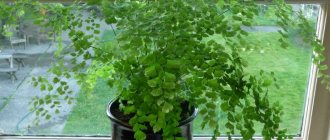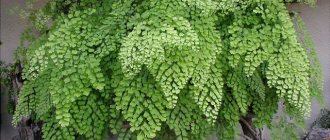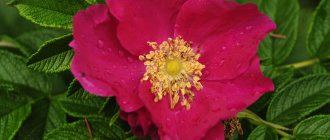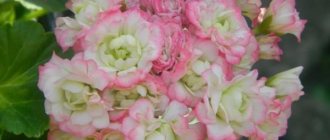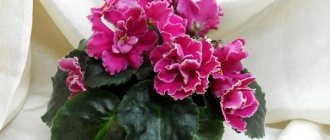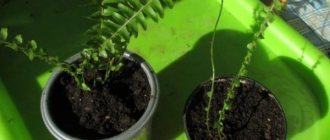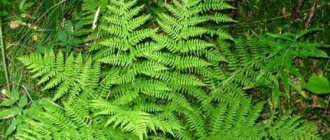Author: Elena N. https://floristics.info/ru/index.php?option=com_contact&view=contact&id=19 Category: Houseplants Published: February 20, 2019Last edits: January 11, 2021
- Dividing the bush
- Adiantum "Venus hair" (Adiantum capillus-veneris)
plant (lat. Adiantum) , or adiantum , is a genus of ferns of the monotypic family Pteris, numbering about two hundred species. The name of the plant consists of the negative particle “a” (not-, without-), the second part of the word translated from Greek means “moisten”, “wet”. Adding up the meanings of these words, one can interpret the name “adiantum” as a “waterproof plant” - and it’s true that the leaves of the plant have the ability to repel moisture while remaining dry. The maidenhair flower grows primarily in the tropics - in East Asia and the South American Andes, preferring rich, moist soils typical of rocks near springs and waterfalls. Adiantum has been known since the time of Pliny the Elder, the author of Natural History, who mentioned the plant in his works. In cultivation, this is one of the most popular ornamental ferns, which is grown both in greenhouses and as a houseplant. In addition to its high decorative qualities, adiantum has healing properties, which we will also talk about.
Planting and caring for adiantum
- Flowering: does not bloom.
- Lighting: partial shade (northern and eastern windows).
- Temperature: in summer – no higher than 22 ˚C, in winter – about 15 ˚C.
- Watering: regular: in summer - 2 times a week, in winter - once. It is recommended to use the bottom watering method: immersing the pot with the plant in a container of water.
- Humidity: high. In hot weather, daily spraying is recommended.
- Fertilizing: from April to September, with a fertilizer solution for decorative deciduous plants in half the dosage specified in the instructions. In winter, the plant is not fed.
- Dormant period: from October to February.
- Transplantation: on average once every 2-3 years.
- Reproduction: division of rhizomes and spores.
- Pests: scale insects, mealybugs, aphids, spider mites.
- Diseases: loss of decorativeness due to improper care.
- Properties: the plant has medicinal properties, widely used in Western Europe and Chinese traditional medicine.
Read more about growing adiantum below.
Diseases and pests
Adiantums are susceptible to diseases and pests. Viral diseases manifest themselves as reddening of the leaves around the edges, then entirely. The disease is transmitted by certain types of insects. The plant will have to be destroyed by treating other flowers against insect vectors. The cause of leaves curling and dying can be the appearance of aphids, spider mites, thrips and scale insects. Insects can be seen with the naked eye; along with them, a sticky coating and cobwebs appear on the leaves. To combat them, insecticides (Fitoverm, Fufa-Nova, Iskra) are used in accordance with the instructions. Scale insects can be removed mechanically - with a cotton pad treated with soapy water. The procedure must be repeated every week.
Botanical description
Adiantum fern is a herbaceous perennial with a thin creeping rhizome covered with black or brown matte scales. Adiantum leaves are opposite or alternate, on shiny dark petioles up to 25 cm long, covered with scales at the base. The leaf blade is green, sometimes gray, wide and smooth, strongly dissected, its wedge-shaped, obovate or trapezoidal segments are fan-shaped. Along the veins on the lower side of the segments there are round, oblong or linear sori with sporangia.
In open-ground gardening, maidenhair adiantum is usually grown, and indoor maidenhair is most often a plant called “Venus hair,” as well as Ruddy’s adiantum, transparent, tender, and others.
Caring for adiantum at home
Growing conditions
The houseplant adiantum does not tolerate direct sunlight, preferring partial shade, so it should be placed near eastern or northern window sills, since the light green lacy leaves of the fern die off from too much light.
- Pruning, replanting and propagation of citrus fruits
Adiantum loves clean air at home, but does not tolerate drafts or dust, so wet cleaning in the room where this indoor fern is located will have to be done frequently, as well as ventilating the room. You cannot smoke near it, and kitchen fumes can destroy the plant. Hot air also harms the adiantum: in summer the temperature in the room with the fern should not rise above 22 ºC, and in winter it is comfortable for it to be in a room with a temperature of 15 ºC away from heaters.
Try to move the pot with the plant as little as possible - it doesn’t like it. But what the indoor maidenhair fern loves is daily spraying with warm water during the hot period, but when the room temperature is cool (this happens in the off-season, when autumn has already arrived, but the central heating has not yet been turned on), spraying can harm the plant. Fertilize the adiantum from April to September with liquid fertilizer for indoor decorative foliage plants in half the dose recommended by the manufacturers once every three weeks. In winter, adiantum does not need feeding.
To preserve the decorative appearance of the fern in the spring, it is advisable to trim off all yellowing, limp and aged leaves so that the plant spends energy on the formation of new fronds. After pruning, the plant is sprayed and watered.
Watering
Caring for the maidenhair fern involves regular watering of the plant, and it is very important not to let the earthen ball dry out, because this can lead to the leaves drying out and dying. Overwatering can cause plant roots to rot.
In order to avoid uneven watering, the maidenhair along with the pot is immersed in a vessel with settled water at room temperature and kept in it until the top layer of soil in the maidenhair pot glistens with water. After this, the fern is moved into the sink, the excess water is allowed to drain and returned to its permanent place. In winter, the plant needs much less water, so it will have to be watered less often, but the principle of watering remains the same. The approximate frequency of watering is twice a week in summer, once a week in winter.
Transfer
Adiantum loves a tight pot, it develops slowly, so it needs to be replanted once every two to three years in the spring, when the roots of the plant begin to peek out of the drainage holes, and the old plant only requires annual replacement of the top layer of substrate 5-7 cm thick. Adiantum has a powerful root system, so the best container for it is a spacious, wide wooden or ceramic pot, unglazed on the inside, with large drainage holes.
Before transplanting the adiantum, a thick layer of drainage material is placed at the bottom of the pot. The soil for adiantum should be loose, acidic and rich in humus, for example, peat with leaf soil in a ratio of 2:1. Sprinkle some substrate onto the drainage layer, then transfer the adiantum from the old pot to the new one and gradually add enough soil to it so that there are no voids left in the new pot. The soil should not be pressed down too hard, as adiantum prefers to grow in loose soil.
Pests and diseases
The chemical composition of maidenhair leaves contains substances that repel insects, but modern pests have learned to adapt even to strong poisons, so maidenhair is sometimes affected by mealybugs, scale insects, spider mites and aphids. Scale insects are removed from the leaves with an ear stick or brush soaked in alcohol.
Against aphids, the plant is treated with a soap solution and then washed off from the leaves, and if this measure does not produce results, you can spray the adiantum with a solution of Actellik, Inta-vir, Decis, Derris, Biotlin, Antitlin or Fitoverm. The last three drugs are also used to combat mealybugs along with insecticides such as Confidor and Confidant, Mospilan or Aktara. Spider mites can be eliminated by treating the fern with Actellik or Fitoverm.
The adiantum is not affected by diseases, but sometimes the adiantum dries out, or rather, from improper care, sometimes the leaves of the adiantum dry out and turn brown at the edges - usually this happens due to insufficient watering or as a result of burning gas in the immediate vicinity of the plant.
If the leaves of a fern fall off, this indicates low air humidity, so spray the plant more often and do not forget that watering should be regular. When the leaves of the adiantum turn pale, this is a sign that it is not in the right place - move the pot with the plant to where it will not be so light.
Curled but not drying fern leaves are a sign of too low a temperature in a high humidity room.
Properties of adiantum
Adiantum leaves contain triterpenoids, flavonoids, lipids, steroids, phenolcarboxylic acids and their derivatives, as well as essential oil. Medicinal powders, infusions, and syrups are prepared from adiantum leaves, which are widely used in Western Europe. Aqueous extracts from adiantum have antibacterial properties, infusions and syrups are used as an expectorant and antipyretic.
- Caring for begonia at home - difficulties
Preparations from adiantum are used to treat diseases of the respiratory tract, as well as diseases of the liver, spleen and bladder. Compresses and lotions against rabid animal bites are made from the juice of fern leaves for detoxification purposes and for the treatment of malignant ulcers. In Chinese medicine, decoctions from the leaves of the plant are successfully used to treat alcoholism. By adding maidenhair juice or a decoction of its leaves to water for rinsing hair, you can reduce the formation of dandruff, and the alcohol infusion helps in the treatment of psoriasis.
Possible growing problems
Most of them are caused by errors in care and maintenance. It is important to understand what error was the specific cause in order to eliminate it if possible.
Shoots and leaf tips dry out
If the air temperature is elevated, it means that its humidity and/or watering are insufficient. Place the pot in a cooler place (preferably on wet stones) and spray more often. In cold air, the situation will be the opposite - air humidification and watering should be reduced.
Foliage turns yellow or becomes too pale
The reason is most likely due to exposure to direct sunlight. Provide diffused light by installing a protective screen (such as regular newspaper) or moving the pot away. It is not advisable to radically change the place; adiantum does not tolerate “moving” well. In addition, yellowing leaves can be caused by a lack of nutrients in the soil or lack of moisture.
The foliage becomes lethargic
A combination of overwatering and cold temperatures. Most likely, at the same time the process of rotting of the root system is already underway. In addition, if the leaves become lethargic, spider mites should be excluded.
The leaves curl without drying out
Increased substrate humidity combined with a constant draft. The plant is overcooled. The next stage will be lethargy of the aboveground part and rotting of the roots.
Adiantum propagation
Dividing the bush
Adiantum at home reproduces by spores and division of the rhizome. In the spring, during transplantation, an adult adiantum removed from an old pot is cut into pieces with a sharp knife, the sections are treated with crushed coal and the sections are planted in separate pots. If the fern has few growing points, then it cannot be divided, as the plant may die. The planted cuttings do not immediately begin to grow; they take a long time to take root.
Before dividing the rhizome, let the earthen lump dry, and when planting the divisions, make sure that the root collar is not too deep in the soil, as this can cause rotting of the shoots.
Growing from seeds
To grow adiantum from spores, use shallow containers filled with a soil mixture consisting of one part peat, half sand and half leaf soil. The soil mixture is compacted and scalded with boiling water. After it has cooled, spread the adiantum spores over the surface, cover them with glass and place the container in a dark, warm place. To disinfect the seed, it is sprayed with a pink solution of potassium permanganate. To speed up the emergence of seedlings, it is advisable to arrange lower heating for the adiantum to 21 ºC. The germination time of seeds is from one week to three months.
After the seedlings hatch, remove the glass and move the container to a well-lit, non-sunny place. When the seedlings get stronger, you need to pick them out at a distance of 2.5 cm from each other, or even better, plant them 2-3 copies in pots with peat soil.
Care
Ferns of this species are quite capricious and require complex care. But the varieties and hybrids bred by breeders feel great both in open space and indoors.
Lighting
When staying in the house, adiantum reacts poorly to direct ultraviolet rays. It is better to keep it in partial shade, choosing window sills with an eastern or northern orientation. If there is too much light, its lacy leaves with a greenish tint begin to die off.
At the same time, it is not at all necessary to place a flower pot on the windowsill. Moreover, in such conditions it often freezes or feels a lack of free space for foliage to grow. A sudden change in habitat also has a detrimental effect on the culture, since it takes a lot of time for it to adapt to the new place.
Expert opinion
Victoria Goncharova
Specialized education: landscape designer, agronomist, gardener. Experience in caring for potted fresh flowers/plants at a professional level!
It is not advisable to change corners to accommodate ferns without special reasons. Even slightly moving or rotating the pot can make its condition worse.
Temperature
Types of adiantum
Adiantum "Venus hair" (Adiantum capillus-veneris)
It grows wild in the mountains of the Caucasus and Crimea, in Central Asia, preferring wet limestone stones near water sources. It has thin black rhizomes. The plant is so named because of its light, delicate fan-shaped light green leaves on petioles up to 25 cm long. It is grown mainly as a houseplant.
Adiantum pedatum
One of the most spectacular ferns, an elegant, openwork plant of the broad-leaved forests of East Asia and North America. This type of adiantum reaches 60 cm in height, its leaves are flat, shiny, one-sided, light green, pinnately dissected, notched along the edges, located horizontally on thin shiny petioles. The species is extremely winter-hardy - able to survive frosts down to -35 ºC.
The best varieties of the species are:
- Compactum is a fern reaching a height of 35 cm;
- Imbricatum is a dwarf variety, a plant up to 15 cm tall;
- Aleuticum - the height of this adiantum is only 10-12 cm with a bush width of 15-20 cm. Most often it is grown in a pot, since it tolerates the sun better than other ferns;
- Japonicum - the height of this variety is about 45 cm, the diameter of the bush is about 30 cm. It is distinguished by copper-pink shoots at a young age, which gradually become green.
Tender maidenhair (Adiantum tenerum)
Or pink adiantum , lives naturally in the Lesser and Greater Antilles and in tropical areas of America. This is a plant with a creeping short rhizome and three-pinnate leaves, wedge-shaped at the base and broadly lobulated along the upper edge, about 70 cm long and up to 50 cm wide, located on petioles up to 30 cm long.
Varieties:
- Farleyens - adiantum with beautifully curled leaves;
- Scutum Roseum - young leaves of this variety, up to 30 cm high, have a variable color from soft pink to green.
Adiantum hispidulum
Or finely pubescent adiantum , grows in the African mountains along the snow line, as well as in India, Australia, New Zealand and Madagascar. The rhizome of plants of this species is creeping, the leaves are palmately dissected, from 15 to 25 cm long, on petioles up to 35 cm long, covered with small bristles. Second-order leaflets up to 2 cm long and up to 0.5 cm wide, also pubescent on both sides with small bristles, are diamond-shaped. A wonderful indoor plant.
Adiantum raddianum
Or wedge-shaped (Adiantum cuneatum) - an epiphyte native to the subtropical forests of Brazil. The leaves are up to 45 cm long and up to 25 cm wide, gracefully curved and dissected into many bright green leaflets on shiny black petioles.
The most common varieties in cultivation:
- Grasillium and Micropinnulum - these adiantums have finely dissected leaves and require high air humidity, so it is best to grow these varieties in a florarium;
- Fritz Loot and Festum are much more hardy varieties that can be grown as houseplants.
Adiantum caudatum
It is grown as a hanging plant, since it produces leaves up to 60 cm long. The petioles of the leaves are brown, with suckers on the tops of the leaves. Plants of this species react very painfully to overdrying of the earthen clod.
Beautiful adiantum (Adiantum formosum)
Or the beautiful adiantum - a large plant up to a meter high with a very fragile rhizome and multi-pinnate leaf blades on purple-black petioles. The leaf segments are dark green, triangular-obovate.
Charming adiantum (Adiantum venustum)
Growing in Nepal and Kashmir, the fern produces narrow, up to 20 cm long, light green leaves on black-purple petioles with slightly pointed segments. After frost, the leaves turn brownish.
Adiantum cuneatum
It is very similar to the beautiful adiantum, differs only in the shape of the sori, which resembles a horseshoe. In nature, this species grows in the south of Brazil.
- Types of araucaria in the photo
Adiantum diaphanum
A herbaceous plant 25-40 cm high with pinnate leaves, double-pinnate at the base. Fronds up to 3 cm wide and up to 20 cm long on thin twenty-centimeter petioles with bare, wide-oval leaves of dull green color.
Adiantum fragrans
Adiantum fragrans, which lives in the South American Andes and South Asia and forms dense bushes, is often grown in cultivation. This is a delicate, rapidly growing plant up to 50 cm high with soft green oval leaves up to 3 cm long and up to 1.5 cm wide on petioles 10-15 cm long.
Venus hair
In its natural environment, Venus hair is found in the Crimean mountains, the Caucasus, and also in the tropics of Central Asia. When choosing a place to grow, it prefers limestone, moist rocky terrain near water sources. The thin root system is black. The name of the species is due to the presence of delicate fan-shaped leaves on long petioles (length about 25 cm) with a pleasant greenish tint. The plant is excellent for home growing and does not require complex care. The bush can grow up to 60 cm in height. According to legend, the bushes of this fern appeared as a result of the fall of strands of hair from the ancient goddess Venus. You can see what the Adiantum Venus Hair variety looks like in the photo below:
Adiantum Venus Hair
